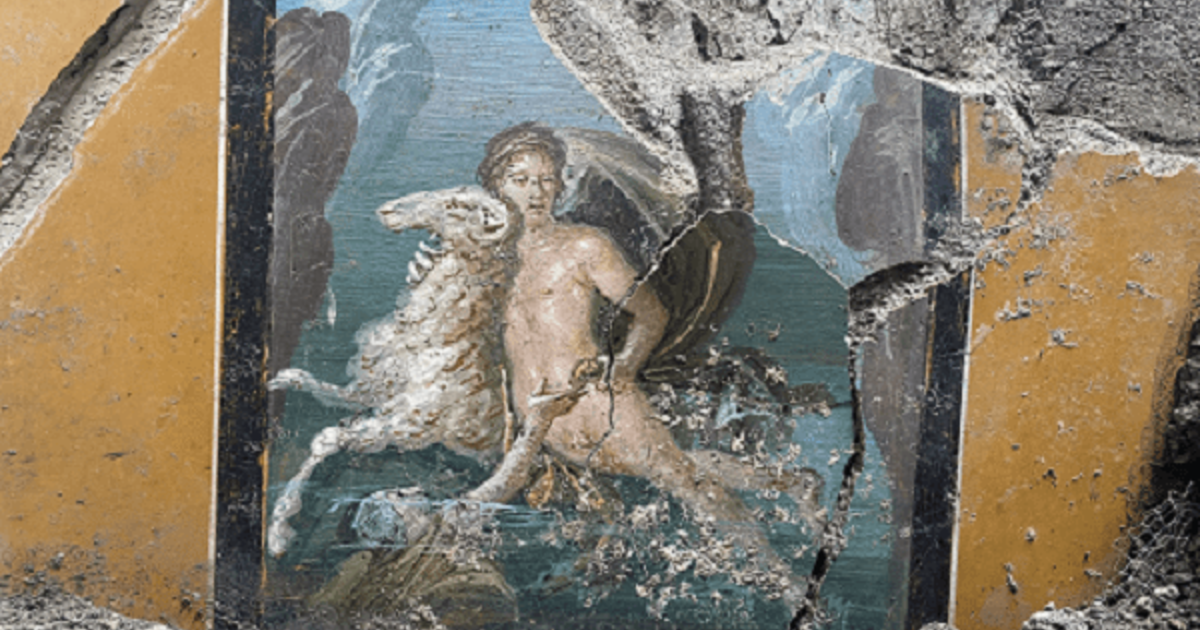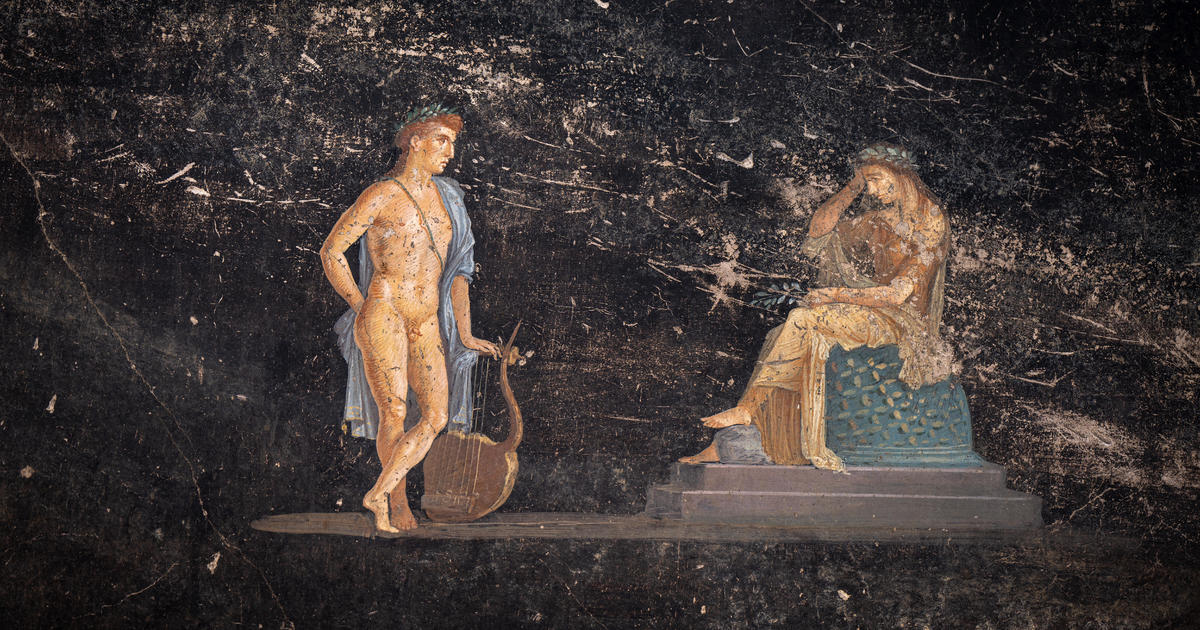CBS News
New frescoes found in ash of Pompeii 2,000 years after city wiped out by Mount Vesuvius eruption

A lavish painting of a mythological scene was among several newly discovered frescoes revealed Friday by archaeologists excavating the ancient Roman city of Pompeii.
Still astonishingly colorful some 2,000 years after the city was wiped out by the eruption of Mount Vesuvius, the frescoes were unearthed during restoration work around the mansion of the House of Leda.
The most striking depicts a scene from the Greek myth of Phrixus and his twin sister Helle, as they fled their stepmother Ino on a magical ram with the Golden Fleece.
Phrixus sits astride the ram while his sister is seen falling into the water, “two refugees at sea from ancient Greece”, noted Gabriel Zuchtriegel, director of the Pompeii archaeological park.
The fresco is painted as if it were a framed picture, hung on a yellow wall. Others depicting still life images and several portraits of women have also been newly revealed.
Excavations at the House of Leda, which began in the 18th century and were relaunched in 2018, aim to reconstruct a complete plan of the site.
The frescoes are being cleaned to remove the volcanic ash that blanketed Pompeii when Vesuvius erupted in 79 AD, and will then be restored.
Many of Pompeii’s buildings — and even some bodies of the estimated 3,000 victims — were perfectly preserved after the eruption.
Pompeii is now a UNESCO World Heritage Site and the second most visited tourist site in Italy, after the Colosseum in Rome.
The discovery of the frescoes come just weeks after three researchers won a $700,000 prize for using artificial intelligence to read a 2,000-year-old scroll that was scorched in the Vesuvius eruption.
The Herculaneum papyri consist of about 800 rolled-up Greek scrolls that were carbonized during the 79 CE volcanic eruption that buried the ancient Roman town, according to the organizers of the “Vesuvius Challenge.”
The scroll’s author was “probably Epicurean philosopher Philodemus,” writing “about music, food, and how to enjoy life’s pleasures,” wrote contest organizer Nat Friedman on social media.
The scrolls were found in a villa thought to be previously owned by Julius Caesar’s patrician father-in-law, whose mostly unexcavated property held a library that could contain thousands more manuscripts.
“Some of these texts could completely rewrite the history of key periods of the ancient world,” Robert Fowler, a classicist and the chair of the Herculaneum Society, told Bloomberg Businessweek magazine.
CBS News
Taste-testing “Sandwiches of History” – CBS News

Watch CBS News
Be the first to know
Get browser notifications for breaking news, live events, and exclusive reporting.
CBS News
“Sandwiches of History”: Resurrecting sandwich recipes that time forgot

Barry Enderwick is eating his way through history, one sandwich at a time. Every day from his home in San Jose, California, Enderwick posts a cooking video from a recipe that time forgot. From the 1905 British book “Salads, Sandwiches and Savouries,” Enderwick prepared the New York Sandwich.
The recipe called for 24 oysters, minced and mixed with mayonnaise, seasoned with lemon juice and pepper, and spread over buttered day-old French bread.
Rescuing recipes from the dustbin of history doesn’t always lead to culinary success. Sampling his New York Sandwich, Enderwick decried it as “a textural wasteland. No, thank you.” Into the trash bin it went!
But Enderwick’s efforts have yielded his own cookbook, a collection of some of the strangest – and sometimes unexpectedly delicious – historical recipes you’ve never heard of.
Harvard Common Press
He even has a traveling stage show: “Sandwiches of History Live.”
From the condiments to the sliced bread, this former Netflix executive has become something of a sandwich celebrity. “You can put just about anything in-between two slices of bread,” he said. “And it’s portable! In general, a sandwich is pretty easy fare. And so, they just have universal appeal.”
Though the sandwich gets its name famously from the Fourth Earl of Sandwich, the earliest sandwich Enderwick has eaten dates from 200 B.C.E. China, a seared beef sandwich called Rou Jia Mo.
He declared it delicious. “Between the onions, and all those spices and the soy sauce … oh my God! Oh man, this is so good!”
While Elvis was famous for his peanut butter and banana concoction, Enderwick says there’s another celebrity who should be more famous for his sandwich: Gene Kelly, who he says had “the greatest man sandwich in the world, which was basically mashed potatoes on bread. And it was delicious.”
Whether it’s a peanut and sardine sandwich (from “Blondie’s Cook Book” from 1947), or the parmesian radish sandwich (from 1909’s “The Up-To-Date Sandwich Book”), Enderwick tries to get a taste of who we were – good or gross – one recipe at a time.
RECIPE: A sophisticated club sandwich
Blogger Barry Enderwick, of Sandwiches of History, offers “Sunday Morning” viewers a 1958 recipe for a club sandwich that, he says, shouldn’t work, but actually does, really well!
MORE: “Sunday Morning” 2024 “Food Issue” recipe index
Delicious menu suggestions from top chefs, cookbook authors, food writers, restaurateurs, and the editors of Food & Wine magazine.
For more info:
Story produced by Anthony Laudato. Editor: Chad Cardin.
CBS News
The cream of the crop in butter

Watch CBS News
Be the first to know
Get browser notifications for breaking news, live events, and exclusive reporting.







